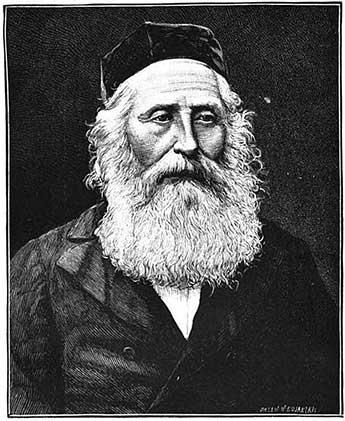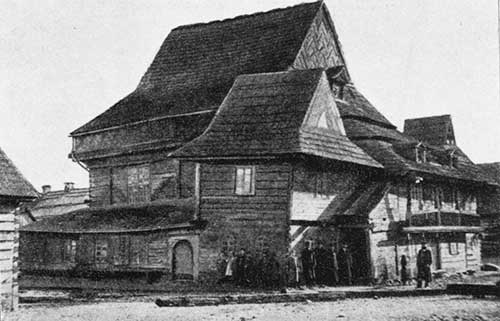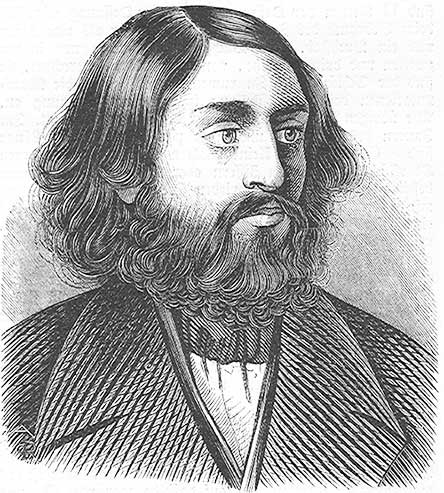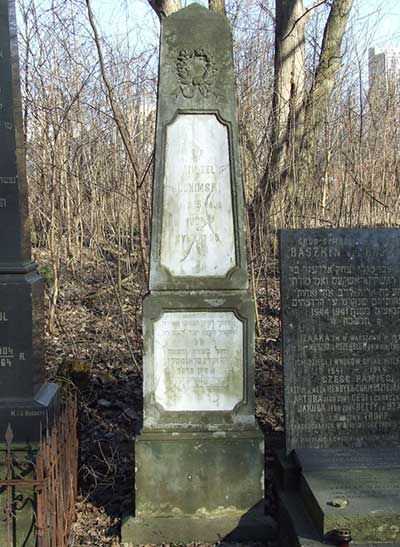
Chaim Zelig Slonimski
Chaim Zelig Slonimski (also known by many name variations through Hebrew, Yiddish, Polish, and the funny Russian version Зиновий Яковлевич Слонимский) was born in a poor orthodox Jewish family on 31 March, 1810, in Byelostok (Byelostok or Bialystok was one of the many towns in Russian Empire (now in Poland), that had a significant (almost 70%) Jewish population), in the Grodno Governorate of the Russian Empire.
He was the oldest son of Rabbi Avraham Ya’akov Bishka (1785–c. 1860), who belonged to a family of rabbis, who were writers, publishers and printers, and his wife Leah (Neches) Bishka, daughter of Rabbi Yehiel Neches, an owner of a well-known House of Study (house of prayer) in Byelostok.
Avraham Bishka, also known as Bishke, ”Yankeleh” and “The Slonimer”, was a son of Rabbi Binyamin Bishka Hakohen Katz, a publisher and printer. Avraham also was a scholar and teacher, but made his living as a pedlar in glass-ware, and made barely enough by it to support his numerous family. It is believed that Avraham worked (or was born) in Slonim (another town in Russian Empire (now in Belarus), that had a significant Jewish population) and “The Slonimer” description became adapted by his descendants as “Slonimski”.
Besides the oldest son—Chaim Zelig, Avraham and Leah Bishka had a daughter, Zimke, and two younger sons, Avraham Avrom (who became a textile manufacturer and merchant), and Jonha (who had a glass shop).
Chaim’s family provided him with a good Talmudic education (he studied at the House of Study of his grandfather Yehiel Neches), and at an early age he already looked upon as a smart boy and demonstrated an interest in mathematics.
There is an interesting (although lacking documentary corroboration) family story, told by Nicolas Slonimsky, a grandchild of Chaim Zelig Slonimski, concerning a solar eclipse which occurred near Bialystok, when Chaim was a small boy. Let’s see:
There was a total eclipse of the sun in the region of Bialystok on September 7, 1820, when my grandfather was ten years old, a date which would bear eloquent testimony to his precocity.
A German astronomical expedition was set up on the site; shiny telescopes adorned the landscape; the weather was perfect for the observation of the celestial phenomenon. The villagers looked with apprehension mixed with wonder at the primly dressed German scientists.
My grandfather, then a boy of tender years, watched the proceedings with unabated curiosity. A German astronomer was moved to speak to him (the Yiddish-speaking natives could understand elementary German without difficulty). “The sun will gradually become smaller and smaller, and soon it will be completely blotted out. But you must not be afraid,” the German reassured the boy. “After a few minutes of total darkness, sunlight will return.” My grandfather listened to the German’s explanations with due respect, and then said, in passable school German: “I know all that. What I cannot comprehend, however, is how you expect to make any worthwhile observations of the corona without a double diffraction lens.” The German was startled. ‘Where did you learn all this?” he asked in utter astonishment. “Why, every street urchin in the village knows such elementary stuff,” was the reply.
The astronomer dispatched a report to the Berlin Academy of Sciences, in which he declared that Bialystok was the most civilized community in the world, and he advanced the theory that this extraordinary state of knowledge amid a largely illiterate population was due to the preservation through the centuries of secret rabbinical doctrines dealing with celestial phenomena.
According to custom, peculiar to the Eastern European Jews, to unite the children early in wedlock, Chaim’s marriage was arranged when he was only sixteen, and on his eighteenth birthday he was given a wife. She was Reiza Rivhas Neches (probably his distant relative) from Zabludow (a small town with a large Jewish community near Byelostok). As usually, the father-in-law took the young couple in his wooden house, located in the market of Zabłudów (where he had a grocery), to pass there the first part of their married life. Chaim and Reiza had two daughters.
In Zabludow the teenager continued his rabbinical studies, but his attention was soon attracted by Maimonides’ treatise Kiddush Hachodesh, and its calculations and astronomical observations captivated his mind. Then he came across the Naaveh Kodesh of Rabbi Shimon Waltosh, a treatise on geometry, trigonometry, and stereometry, and mastered it for a short time. The next was the Hebrew translation of Elements of Geometry of Euclid by Rabbi Baruch Sclower, then the Shebilay Derakiah of Rabbi Elijahu Heches, a rare mathematical treatise, then the Euler’s Algebra, then the Mennig’s Cursus of Mathematics, in four volumes (he needed two months to finish this ponderous work). Another opportunity brought him together with a pharmacist in Bialystok, who volunteered to teach him German.

The unique wooden synagogue in Zabludow, built in 1637 of oak tree (a photo from 1895). It was burnt by the Germans during the Second World War.
In 1831 the three years, during which time his father-in-law had engaged to support him and his family, were passed, and being without means, and without any business, dreary prospects were before Chaim. Nothing remained for him than to accept the place of bookkeeper with his brother, who owned a glass manufacture, some 60 km from Bialystok, deep in the woods. For a year and a half every hope of progress was taken from him. Fortunately he found the mathematical works of Abel Berrias in eighteen volumes, and in the deep hour of night only was he able to pursue his beloved studies.
Sometime in 1831 or 1832, knowing that the Jewish literature had no works in that line, and that the Eastern European Jews had no opportunity to study mathematical works in a foreign language, Chaim undertook to write a whole course of mathematics, both the pure and applied, in the Hebrew language. Thus he wrote a manuscript, Mosede Hokmah (On the Principles of Mathematics), but nobody would have ever heard of that hidden knowledge, if a kind Providence had not furnished him an opportunity. In 1833 his brother sent him for a business trip to Grodno, the governorate center. There Chaim met Eliezer Rosenthal (1794-1868), a famous Jewish book collector, who encouraged him and advised to go to Wilna (Vilnius, the capital of modern Lithuania), where there are a Jewish printing office and a host of learned men, who will help him to get his works published.
Thus in 1834 Slonimski travelled to Wilna and asked for financial support from the first men of the local Jewish community. A subscription list was opened, but by reason of the poverty of the Jews it had not much success. The printers were not enterprising enough to take hold of a new work in Jewish literature. The expenditure of a thousand roubles appalled them, and thus Chaim was forced to publish only one part (which treats of Algebra) of his great work.
From Wilna Slonimski went to Minsk, where the young mathematician enjoyed the most marked attention, and encouraged by his first success in mathematics, he returned to Zabludow. Although he drew upon himself already, by the publication of scientific works, the name of a Berliner (sectarian), as they called him tauntingly in his small town, and although his wife felt greatly chagrined by the danger which the orthodox reputation of her husband run, yet she relaxed in her opposition, when the silvery sound of 75 roubles struck upon her ear. A year and a half he passed now under his domestic roof, enjoying greater freedom for study. He ordered several books from Leipzig, for a pamphlet on Halley’s comet, which he intended to publish.
Thus in 1835 Slonimski released Sefer Kukba di-Shebit, a collection of essays on the Halley comet and other astronomy related topics such as laws of Kepler and Newton. This work significantly increased his popularity, because Halley’s comet was widely discussed topic as the return of this periodic comet was expected in 1835. Rapaport, Reggio, Geiger, and other scholars, began to correspond with him, and from all parts he received encouraging words.
In 1836 Chaim Zelig visited again Wilna, Warsaw, where he passed a few weeks with the mathematician Abraham Jacob Stern, and went from there to Königsberg. Stern, a prominent member of the local community, became his patron.
When in 1836 Slonimski returned to Zabludow, his domestic troubles got worse and worse, and only the last remedy, so frequently used among the Polish Jews, remained to him, to divorce himself from his wife. Deprived of all means and the only support for his small children, at the end of 1836 he returned to Bialystok, his native place, and poverty in all its nakedness starred him in the face.
But his ill-luck had reached its climax, and fortune began from now to smile on him. Abraham Stern got information of his misfortune, and with a parental kindness, he invited him and his family to his house in Warsaw, and highly recommended him to the local Jewish community. Thus Slonimski obtained a permanent situation among the numerous beneficial societies of the Polish capital and get the support by Itshak Shimon Rosen, a prominent banker.

Chaim Zelig Slonimski in 1840s
Moreover, later Stern offered him the hand of his youngest daughter, Sara Gitel (1824–1897). Thus in early 1842 Slonimski married to Stern’s daughter. They had five children: Abraham Jakub (1845-1849), Leonid Ludwig Zelig (1 Nov. 1849-1918), Michal (b. 1850), Stanislaw (1853-1916), and Josef (1860-1934).
In 1838 Slonimski’s work on astronomy, The History of the Heavens, appeared in Warsaw with introductions in Polish by two prominent Polish astronomers.
Financial troubles constantly plagued Slonimski, and the ability to organize his affairs was completely alien to him. In late 1840s by a stroke of luck he managed to sell the rights of the manufacture of his adding machine to England for £400, a huge sum for the time. He invested the money in the acquisition of a fruit orchard in the town of Tomashov, and engaged in gardening and making experiments in the preparation of pottery on a new method invented by him.
In 1850s and 1860s Slonimski continued his scientific pursuits. In 1853 he invented a chemical process for plating iron vessels with lead. In 1856 he designed an electrochemical device for sending quadruple telegrams, which enabled simultaneous double transmission and reception—four active communication channels were open through one wire at the same time. In April , 1858, he addressed a letter to the Directorate of the Russian Ministry of Transportation, in which he revealed a thorough understanding of the processes that take place in duplex telegraphy, and for the first time proposed a method to obviate certain difficulties of simultaneous transmission of messages over the wire. Despite the novelty of his proposal and the feasibility of its practical application, he failed to obtain the necessary funds for his experiments. In 1859 Slonimski published a separate brochure containing a detailed description of his method. The system of multiple telegraphy, which was used by Lord Kelvin in 1858, was based on Slonimski’s discovery. Later, the same invention was repeated by Thomas Edison, who could hardly have known anything about Slonimski’s work.
In 1863 Chaim Zelig Slonimski was appointed government censor of Hebrew books in Zhitomir and was named inspector of the rabbinical seminary (a government-sponsored rabbinical school). He served as inspector for 12 years, until the Russian authorities closed such seminaries down.
First in history, Slonimski began writing and publishing science books in Hebrew to enlighten the Jewish population in Eastern Europe. He started publishing a popular science magazine, Ha-Zefirah, 1862, in Hebrew, which continued after his death, till 1931. Ha-Zefirah was a cultural event of prime importance in the Jewish community because of the vast amount of miscellaneous information that was generously spread across its pages. Until the last decade of 19th century Slonimski strove to develop a broad Jewish scientific discourse that would be accessible to as many educated Jews as possible.
Chaim Zelig Slonimski was an idealistic, but impractical genius. Let’s look how is he described in the Энциклопедический словарь Брокгауза и Ефрона (The Brockhaus and Efron Encyclopedic Dictionary is a comprehensive multi-volume encyclopedia in Russian), published in 1900 (one of the editors of this encyclopedia was his son Leonid Ludwig), when he was still living:
The mathematical gifts and inventive power with which Slonimsky astounded both theoretical and practical scientists in his youth, were not exploited by him in full, partly because of the unfavourable living conditions of Russian Jews and partly because of Slonimsky’s own intellectual idiosyncrasies. Once he had found the solution of a specific problem…, he was in no hurry to publish his findings… and often laid them aside for many years until the foreign scientific periodicals announced these inventions as new accomplishments of some Western scientist.
Chaim Zelig Slonimski carried on in excellent mental and physical health well into his tenth decade (he inherited his longevity from his grandfather, Yehiel Neches, who also lived to 95, and his grandchild, the composer Nicolas Slonimsky, died in 1995 at the age of 101). He died on 15 May, 1904, in Warsaw. His gravestone in the Jewish cemetery on Okopowa str. in Warsaw is still preserved (see the image below).

Slonimski’s gravestone in the Jewish cemetery on Okopowa str. in Warsaw
The image featured at the top of this post is ©G-Stock Studio/Shutterstock.com.


